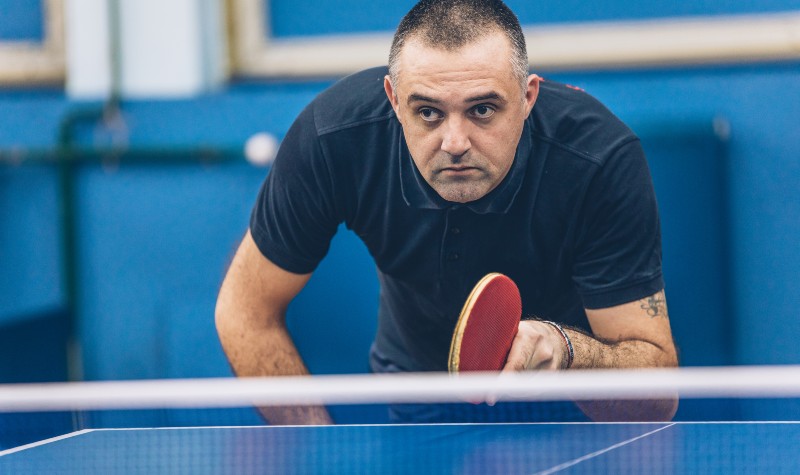How to return any table tennis serve

Returning serves is the hardest part of table tennis for many players. For beginners it can feel like an impossible challenge. Even advanced players can lose a lot of points from missed returns of serve.
When you’re at the beginner / intermediate stage, it may seem tempting to try out all the advanced ways of returning serves – short touches, spinny flicks, power loops – but this usually ends in far too many unforced errors.
What should you do instead? If you are learning to play table tennis, or generally struggle to return serves – I recommend you initially reduce your options to only four shots:
- A backhand push
- A forehand push
- A backhand drive
- A forehand drive
These four strokes can be used to return any table tennis serve.
“No way! Tom, you’re talking nonsense. This will never work.”
Don’t believe me? Let’s look at all the different types of service spin you will face and which of these four shots can be used to return them.
Topspin serve – This can be returned with a forehand or backhand drive. You don’t need to hit the ball particularly hard, as the topspin serve will have plenty of energy already. You just need to contact towards the top of the ball, with a slightly closed bat angle and the ball will be returned.
Sidespin and topspin serve – This can be returned with a forehand or backhand drive also, in the same way as a topspin serve. To control the sidespin you need to aim your return to a different part of the table. If in doubt, aim for the middle and the ball will land somewhere.
Backspin serve – This can be returned with a forehand or backhand push. If it is heavier backspin, you will need to brush under the ball more. If it is lighter backspin, you will need to brush down the back of the ball more.
Sidespin and backspin serve – This can be returned with a forehand or backhand push also. You may need to direct your push into a different area of the table to account for the sidespin. If in doubt, aim for the middle of the table.
Float serve – A serve with very little spin can be returned with any of these four shots – forehand / backhand drive or forehand / backhand push. If returning with a drive, you will need to open the angle a little more and hit through the back of the ball. If returning with a push, you will need contact down the back of the ball.
Surely it can’t be this easy? Well yes and no.
There is only ever going to be a limited number of service spins you will face. Players are capable of varying their service action and varying the degree of spin. But players can’t invent new types of spin. So you will always face topspin, backspin or sidespin with topspin / backspin. A float serve is never truly without spin. There will always be a tiny bit of topspin or backspin.
So you can feel reassured that if you know how to play a forehand / backhand push and a forehand / backhand drive, you have the tools to be able to return any serve you will face.
The tricky part is reading the service spin in the first place. This is where the server has the real advantage. The server may use different service actions, different placements, different spins. The server may use some deception and make you think the serve is one type of spin, when really it’s another.
So whilst the solution to return any type of serve is quite simple, reading the spin, executing the stroke correctly and returning the ball in a way which puts your opponent under pressure is still really difficult.
So what should you do? If you’re learning to play table tennis or you have played for some time, but really struggle to return serves, I recommend keeping your options really simple. Just use pushes and drives for the time being and put all your energy into learning to read the spin. I have some tips on reading spin in this article.
When you get much better at reading service spin and have high consistency in returning a lot of serves, then you can progress onto more advanced options – touch shots, flicks, loops. Get the basics right first. Walk before you can run. Push and drive, before you flick and loop.















![Toni Kroos là ai? [ sự thật về tiểu sử đầy đủ Toni Kroos ]](https://evbn.org/wp-content/uploads/New-Project-6635-1671934592.jpg)


